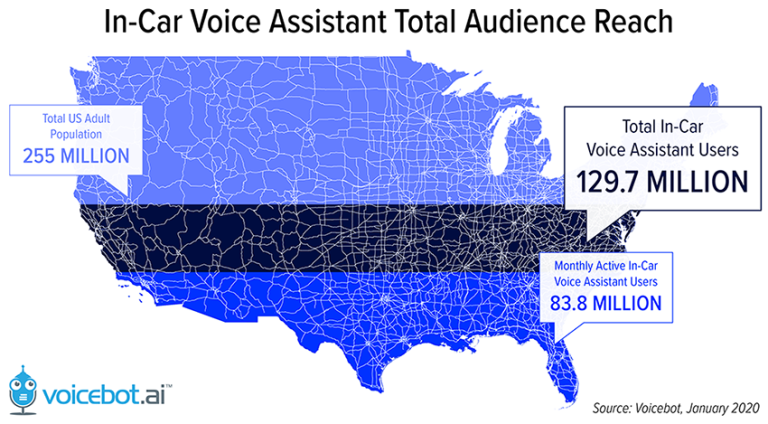The automotive industry had been making significant leaps forward in convenience and connectivity via in-car voice assistants that benefit both drivers and passengers. A rapidly growing number of people are already using voice assistants in cars, and automakers are continuing to invest in creating better user experiences via custom, branded voice assistants. Leading manufacturers like Mercedes-Benz, Hyundai, Honda, PSA, and Kia have already announced sophisticated, branded voice assistants that help users access a wide range of services, hands-free.
According to research by VoiceBot.a, U.S. adults that have used a voice assistant in the car went up by 13.7% between September 2018 and January 2020 to 129.7 million. Monthly active users also rose during the period to 83.8 million.
Tens of millions of people are now using voice assistants in their cars for hands-free convenience, safety, and 24/7 connectivity.
Most popular in-car voice AI uses cases
Brands building voice solutions to improve user experiences should focus on speed, accuracy, personalization, and extended functionality. Cloud connectivity will become a key element for successful in-car voice experiences in the future. Without it, the fastest growing use cases for voice assistants in the car won’t be possible.
The most popular in-car voice use cases include access to entertainment and information, similar to those that can be achieved with a smart speaker at home. Not only do people want to roll up the windows or control the air conditioning, they want answers from the cloud and they want them anytime, anywhere.
Here are the 5 top in-car voice use cases today in order of popularity:
1. Playing music and checking for directions
The most popular use cases for voice assistants in-car are to help with tasks most closely associated with driving or being a passenger. Listening to music, changing the radio station, and getting driving directions top the list.
Music is an important part of our lives helping us unwind, celebrate, energize and connect with each other. The right song can lift your mood, stimulate your mind, and help you connect with cultures around the globe. So being able to use your voice to play any song, artist, genre, or playlist without ever taking your hands off the wheel or your eyes off the road is invaluable to drivers. The most popular voice assistant use cases include playing specific songs, artists or podcasts, changing radio stations, and controlling volume.
Capgemini predicts that 85% of consumers will be using a voice user interface for music and navigation by 2022.
And now with streaming platforms like Pandora’s Voice Mode, drivers can simply use the wake phrase “Hey Pandora” to control the app hands-free. With Pandora’s handy voice feature, you can play songs, change stations, control volume, skip songs, and even make requests like, “Play me something for my drive.”
In the future, playing music, checking for directions, and other in-car functions are forecasted to remain top in-car voice assistant use cases. In fact, Capgemini predicts that 85% of consumers will be using a voice user interface for music and navigation by 2022.
2. Integrating with at-home devices and everything else
When we get in a car, we’re often either leaving home or returning. It makes sense that consumers would want to be able to interact with in-home devices in both of these scenarios. Car manufacturers are aware of this and are already planning for their vehicles to become an integral component in the overall internet of things (IoT) in the near future.
According to a report by Business Insider, automakers have noticed a growing trend in connecting cars to the internet and predict that the “Internet of Vehicles” will surge in the coming years. Business Insider Intelligence expects connected car shipments to rise from 33 million in 2017 to over 77 million by 2025.
The growth and adoption of in-home voice assistants and the IoT in the smart home has produced a desire for consumers to be connected to their homes and to be able to access their smart home devices from anywhere. Hands-free access in the car to thermostats and security devices in the home provide a greater sense of security and convenience for people traveling away from home or returning.
It’s often the mundane things that make people’s lives better. Whether that’s the ability to turn on the air conditioning or the living room lights before arriving home, or checking to make sure the lights are off and the doors are looked after leaving, in-car voice assistants that improve people’s daily lives is the ultimate goal for car manufacturers.
According to industry analysts, by 2025, connectivity between the car and the IoT will not be limited to car and home. Statista predicts that the market for vehicle-to-everything (V2X) technologies is expected to grow to around $6 billion U.S. dollars. This trend signifies communication between vehicles, pedestrians, and infrastructure.
3. Booking an appointment for a service
We never think about booking that appointment to get our car’s oil checked, the tires rotated, or the 50,000 mile check-up until we’re in the car. That’s when people want their voice assistant to make the process fast and easy. As soon as the check engine light or the tire pressure light illuminate, consumers want to book an appointment for service from the car. Offering a hands-free voice assistant that can understand complex and compound queries and respond accurately and quickly will transform this use case from a multi-step transaction to a quick, personalized conversation between the service provider and the consumer.
According to Capgemini, by 2022 74% of consumers will be extremely comfortable using voice to book appointments and will prefer to use the in-car voice assistant to help. As chatbots and voice assistants populate contact centers, people will begin to expect to connect quickly to any business and get the information and appointments they need without the inconvenience of navigating through endless voice prompts and long hold times.









